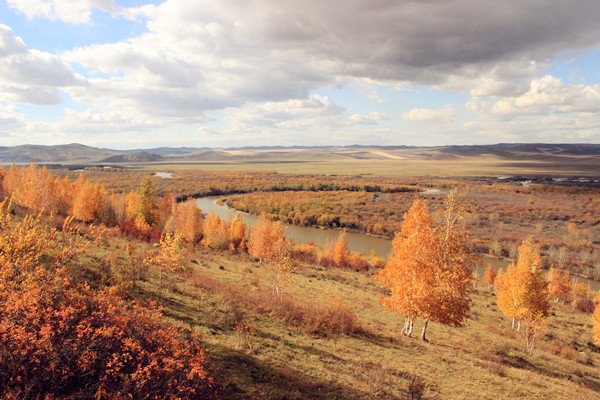Forests and grasslands
 |
The Inner Mongolia autonomous region has one of China's largest forested areas and is an important site for ecological protection in northern China, with 23.66 million hectares of forest, or one-eighth of the nation's total, totaling 21.03 percent of forest coverage. |
The Inner Mongolia autonomous region has one of China's largest forested areas and is an important site for ecological protection in northern China, with 23.66 million hectares of forest, or one-eighth of the nation's total, totaling 21.03 percent of forest coverage.
Wetland resources
Aside from the oceans, rivers, lakes, swamps and constructed wetlands are some of the water resources in the region. It has 6.01 million hectares of wetlands, which accounts for 11.25 percent of the national wetland areas. The region has established a protection system giving priority to wetland nature reserves and wetland parks, protecting 1.72 million hectares of wetlands with a protection rate of 28.5 percent.
Nature reserve
150 nature reserves have been established by the forestry department, of which 24 are national level and 48 are autonomous region level. They are forest ecosystem, wetlands ecosystem, desert ecosystem and wild animals and plants, with a total area of 10.47 million hectares.
Forestation
During the 12th Five-Year Plan (2012-2016), the total forestation area reached 1.01 million hectares, accounting for one-ninth of national areas. Forestation of 0.41 million hectares of key areas has been completed, and more than 380 projects have since been developed.
Statistics from the Inner Mongolia authority reveal that the area of forest land in the entire region has increased from 137 million mu (9.13 million hectares) at the beginning of the funding of the autonomous region to 392 million mu in 2021, and the forest coverage rate has reached 23 percent, due to the region's greening efforts.
The area of desertified and sandy land throughout the whole region has seen a "double reduction" for the past many years.
The barren hills of Sumu Mountain in Xinghe county, Ulaanqab city have turned green, with a forest area of 202,300 mu and a forest coverage rate of 74.8 percent, making it the largest artificial forest farm in North China.
In addition, one-third of the Kubuqi Desert is now forested, becoming a model for the global fight against desertification.
During a video conference on forestry and grassland work held on Feb 4, it was revealed that North China's Inner Mongolia autonomous region plans to afforest an area of over 3 million mu (200,000 hectares), plant over 13 million mu of grass, and carry out sand control and desertification treatment on an area of over 15 million mu in 2024, aiming to build an ecological barrier in northern China.
In so doing, in 2024, Inner Mongolia will step up sand control and desertification treatment as well as integrate wind power and photovoltaic projects, striving to achieve high-quality treatment of over 900,000 mu of desertified land with new energy sources.
Efforts will be made to enhance the quality of forestry and grassland construction, including the improvement of forest quality, the development major projects for grassland protection and restoration, and the promotion of afforestation in key areas.
The region will also focus on strengthening the construction of large-scale forest farms, aiming to grow 889,200 mu of forest, restore and manage 5.73 million mu of degraded grassland, afforest 120,000 mu of land in key areas, and carry out ecological construction tasks on 255,000 mu of land in large-scale forest farms throughout the year.
Simultaneously, Inner Mongolia will explore the establishment of a diverse investment mechanism, primarily driven by national investment but with local support and widespread participation from enterprises.



 Print
Print Mail
Mail





